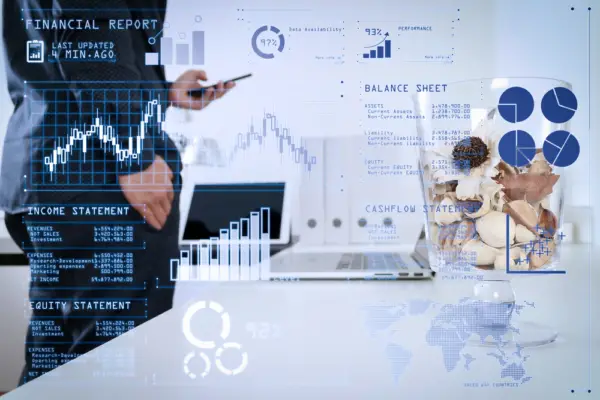Banks are in the business of managing risk. To do so effectively, they need to clearly understand the risks they face and develop strategies to mitigate them. This is where key risk indicators (KRIs) come in. KRIs are quantifiable measures that provide insight into a company’s overall risk appetite and exposure.
Banks face significant risks in a constantly changing environment in today’s global economic environment, with risks in any field likely to have adverse effects in other areas. The ABA Banking Journal says cybersecurity threats continue to top many banks’ risk lists.
The most common KRIs used by banks include loan-to-deposit ratio, non-performing loans, capital adequacy ratio, liquidity ratio, net interest margin, quick ratio, current ratio, value at risk (VaR), number of accounting deadlines missed, and political climate.
Each KRI provides an early warning signal when risk trends or risks increase or decrease in relation to business objectives.
For example, a high loan-to-deposit ratio indicates that the bank is taking on more risk than it can handle. On the other hand, a low liquidity ratio suggests that the bank may not have enough cash on hand to cover its obligations.
In addition to traditional KRIs such as those mentioned above, banks should also consider emerging risks such as cybersecurity threats and third-party relationships. As technology advances and regulations change rapidly, banks must stay ahead of the curve in order to protect themselves from unexpected losses.
Every financial institution in every sector has security concerns and the banks should monitor technological improvements to prevent hackers from targeting vulnerable systems or data. The threat is not limited solely to cybercrime and ransomware.
Changing politics affect credit ratings, and all need to be included and develop risk mitigation plans. The plan will be for key operational risk indicators depending on generally accepted accounting principles and financial reporting processes.
In this blog post, we’ll discuss some examples of KRIs that every bank should be tracking.

Credit Risk
Credit risk is the loss risk arising from a borrower’s inability to repay a loan. For banks, credit risk is one of the most important types of risk to monitor. Several indicators can be used to measure credit risk, but some of the most important include loan-to-value ratios, non-performing loans, and charge-offs.
Operational Risk
Operational risk is loss arising from inadequate or failed internal processes, people, or systems. Examples of operational risks include cyberattacks, data breaches, and human error. Measuring operational risk can be difficult, but some indicators that banks can use include incident reports, customer complaints, and audit findings.
Market Risk
Market risk is the risk of losses arising from adverse market price movements. For banks, this includes interest rate risk and foreign exchange risk. Some indicators that can be used to measure market risk include changes in interest rates, changes in foreign exchange rates, and changes in the price of financial instruments such as stocks and bonds.
Asset Quality
This KRI measures the quality of a bank’s assets, such as loans. It’s important for banks to keep track of this KRI because it can be a leading indicator of financial trouble. For example, if a bank has a high percentage of non-performing loans, it could be a sign that the bank is at risk of defaulting on its obligations.
Liquidity
This KRI measures a bank’s ability to meet its short-term obligations. Banks need to monitor their liquidity because they could run into trouble if they don’t have enough cash on hand. For example, if a bank has too many depositors who want to withdraw their money at the same time, the bank might not have enough cash on hand to meet all of those requests.
Capital
This KRI measures the amount of capital a bank has on hand. Banks need to monitor their capital because they could run into trouble if they don’t have enough.
For example, if a bank doesn’t have enough capital, it might not be able to cover its losses if there is an economic downturn. Financial and reputational penalties may arise when capital ratios fall under capital ratios statutory requirements.
Earnings
This KRI measures a bank’s profitability. It’s important for banks to monitor their earnings because if they’re not making enough money, they could run into trouble. For example, if a bank isn’t making enough money, it might not be able to cover its expenses and might need to lay off employees or close branches.
What are key risk indicators for banks?
Key risk indicators are defined as quantitative indicators used by banking managers as part of the assessing process that affects the financial institution. Kris serves as a warning rather than measuring what happened.
This data is used by financial institutions for the forecast of risks that affect a firm or to manage risks and provide a forward view of risk events for evaluating future ventures.
A key risk indicator (KRI) is a metric used by banks to precisely and accurately evaluate the potential risk associated with their operations. These key performance indicators are designed to measure an event’s likelihood and consequences, allowing banks to determine whether their operational risk exposures are within acceptable limits.
KRIs can be used to monitor a variety of risks, including credit, operational, liquidity, market, and reputational risks. KRIs include loan-to-deposit ratio, non-performing loans, capital adequacy ratio, liquidity ratio, net interest margin, number of missed accounting deadlines, and value at risk (VaR).
How to use a list of sample key risk indicators
Identify effective KRIs that are effective in risk assessment and reporting. To use key risk indicators in determining bank performance, you must first choose the optimal selection of risk indicators and ensure they target the underlying cause of the event that you measure.
Tracking KRIs can predict failure, so you can avoid this future by providing additional resources, training employees, or applying other strategies.
Key risk indicators (KRIs) are metrics used to measure the risks that a business is exposed to. They act as an early warning system, allowing organizations to identify and address potential risks before they become major issues. A sample key risk indicators list can be a valuable tool for businesses looking to reduce their risk exposure.
When selecting sample key risk indicators, it’s important to consider your organisation’s specific needs. Different industries and businesses will have different types of risks that need to be monitored.
For example, a retail business might focus on customer complaints or sales figures, while a financial institution might look at credit ratings or market volatility. It’s also important to select NIST KRIs that are measurable and relevant – ones that will provide meaningful data about the current state of your organization’s risk profile.
Once you’ve identified the appropriate sample key risk indicators, you’ll need to set up tracking systems for each one. This could involve using software tools or manual processes such as spreadsheets or databases.
Finally, it’s important to review your list of sample key risk indicators regularly and adjust them as needed based on changes in your industry or business environment. Doing this will help ensure that your KRIs remain relevant and useful in helping you manage your organization’s risk profile over time.
Banking Key Risk Indicator Dashboard
A key risk indicator (KRI) dashboard is an important tool for banks to measure and monitor their exposure to risk. KRIs are numerical values that indicate the level of risk in a banking institution and can be used to identify, measure, monitor, and control or manage potential risks.
The top KRI categories for bankers in 2020 include credit, operational, market, liquidity, compliance, and reputational risks. For example, credit KRIs may include loan defaults, loan delinquencies and non-performing loans.
Market risk KRIs may include volatility indices or value-at-risk calculations. Liquidity KRIs may include cash flow ratios or funding liquidity ratios. Compliance KRIs may include the number of regulatory breaches or customer complaints. Reputational KRIs may include customer satisfaction surveys or brand reputation scores.
KRIs are useful tools for business lines managers, senior management and boards to help monitor an organisation’s risk-taking level.
Once your risk indicators are narrowed down, you can import them onto an e-mail account. Nevertheless, Tableau and Domo have worked equally well and are available for purchase.
Operational Risks
The second most important KRI category within the banking industry involves operational and regulatory risks. Operational risks refer to losses due to the failure or inadequacy of an employee’s controls, procedures, or policies.
Operational risks are a major concern for banks, as they can lead to significant losses due to errors, breaches, interruptions or damages. Banks must take steps to manage these risks in order to improve profits and sustain long-term success.
Examples of operational risks include third-party, internal and external fraud, digital transformation, cyber, and data privacy risks. Prudent risk management is key for banks when it comes to operational risks.
It is important for banks to have an effective operational risk management system in place that can identify and address potential issues before they become costly problems. This includes having processes in place that monitor operations regularly and ensure compliance with regulations.
Banks should also use technology such as artificial intelligence and machine learning to detect any anomalies or suspicious activity that could indicate a potential operational risk.
Operational risk management involves an integrated approach involving the analysis and assessing risk, decisions on risk and adoption of internal controls.

How to develop Key Risk Indicators for your business?
The KRI must be designed to understand a business’s risks. Key risks include the identification of the major risks. Such risk is the risk that is most likely to exist, the one with the biggest effect or the risk outside our company’s control.
It is relatively simple to generate KRIs from your existing KPIs. A KPI indicates your organisation’s greatest need. It will save time in assessing key areas for businesses. You must select KRIs that are pertinent, quantifiable, and timely.
In developing KRIs, it’s important to consider three essential characteristics: measurability, quantifiability, and accuracy. Measurability means that the KRI must be able to be measured in some way. Quantifiability requires that the KRI can be expressed numerically so that changes over time can be tracked. Accuracy ensures that the KRI provides reliable data about the risk being monitored.
The first step in creating KRIs is identifying your business’s risks. Consider both internal and external factors, such as financial performance, customer satisfaction, employee turnover rates, market trends, etc., that could potentially lead to negative outcomes for your organization. Once you have identified these risks, you can begin to develop indicators for each one.
When creating KRIs for each risk factor, think about how you will measure them and what thresholds should trigger an alert when exceeded or dropped below a certain level. You may also want to consider how often you will need to review these indicators and who should be responsible for monitoring them on a regular basis.
Choosing KRIs & Challenges
Developing KPI strategies to achieve business goals is the best way to decide which KRI to choose. Kris has a minimum risk assessment before they begin to take action on the basis of risk. At this time, we want to emphasize the importance of determining how KRIs work.
When you implement risk management strategies, you will take steps relating to KRI that trigger the necessity for action. It’s difficult to choose KRIs and track them.
KRIs can be challenging to create and measure but essential for effective risk management. By monitoring KRIs, organizations can better understand their risk profile, predict risks, and take proactive steps to reduce or eliminate potential threats.
Overall, KRIs and challenges go hand in hand when it comes to managing risks in any organization. By utilizing KRIs effectively, organizations can quantify market risk and ensure that they are prepared for any potential risks that may arise in the future.
Examples of Key risk indicators in the Banking Industry
Operational Risk Indicator Example # 1 – Percentage of Projects Currently in Progress That is Delayed (Overall)
Project risks definitions (Megaprojects) The number of projects that have been delayed as a percentage of the total number of projects that have been delayed during the measurement. KRI – This measurement identifies the risks associated with delayed projects.
Increasing delays can indicate problems with planning, allocation of resources and capacities of the project execution budgeting, the management report and overall project management. Excessive project delays impose significant economic and strategic risks on organizations.
Credit Risk Indicator Example # 2 – Current Ratio
Types of risk – Liquidity Risk Definition – A measure of an organization’s current liquidity is measured as a percentage of total current liquid assets and illiquid assets and liabilities. KRI is an indicator of a business’s ability to pay its current liabilities based on its assets.
The lowest value of the metrics indicates a huge amount of liability which is insufficient to cover the current asset value in the organization.
Credit Risk Indicator Example # 3 – Quick Ratio
Type risk definition – liquidity risk definition – measures the organisation’s current liquidity. KRI is used to assess a firm’s ability to pay out liabilities with the help of liquid assets.
A value lower than 0 indicates that a company’s liability has reached an extent that cannot be covered by the current assets. The organization may face the risks posed by failing to meet financial obligations, financial penalties and reputational penalties.
Credit Risk Indicator Example # 4 – Days Payable Outstanding (DPO)
Types of risk – credit risk definition – How many calendar days the organisation has to pay off the account balance? The reasons to measure this KRI. The measurement of risk generally involves companies’ suppliers to vendors.
Low DPO numbers can cause cash flow issues (i.e., payments too fast). However, high DPO numbers can have a negative impact on credit terms negotiated with certain providers. The department responsible for Accountable payable must determine an optimal balance in line with the business liquidity requirement.
Credit Risk Indicator Example # 5 – Percentage of Invoices Paid On-Time
The number of invoice payments in full as a percentage of total payment in the measurement period. The reason behind evaluating this KRI: This metric measures risks associated with organizations’ adherence to specified credit conditions, as defined in an invoice or negotiated by a provider.
In some cases, an excess of late invoice payments can negatively affect the payment terms negotiated by the vendor. Some companies may offer special offers on bills repeatedly paid late or late, avoiding this is the best way.
Operational Risk Indicator Example # 6 – Total Number of Post-Close Adjustments
Type of Risk Reporting Definition: Number of adjustments completed after closing over the measurement period. Reasons for determining KRI: It measures the risk from the excessive amount of changes required during closing.
A post-closing adjustment is typically related to omissions in accounting journals, reports and related output that could indicate that the organization does not maintain the appropriate accounting control measures in place. Excessive adjustments after closing may adversely affect organizational capacity as a result of new work.

Operational Risk Indicator Example # 7 – Percentage of Post-Audit Report Recommendations Still Outstanding – Overall
Corporate Risk Definition. KRIT is the measure of a company’s diligence in implementing recommendations made during an audit. High values indicate the organization didn’t implement post-audit recommendations in timely terms.
Conclusion
Banks need to clearly understand the risks they face and develop strategies to mitigate them. Key risk indicators (KRIs) are quantifiable measures that provide insight into a company’s overall risk exposure.
In this blog post, we discussed some examples of KRIs that every bank should track, including credit, operational, and market risks. Banks can more effectively manage their risks and protect their bottom line by tracking these indicators.

Chris Ekai is a Risk Management expert with over 10 years of experience in the field. He has a Master’s(MSc) degree in Risk Management from University of Portsmouth and is a CPA and Finance professional. He currently works as a Content Manager at Risk Publishing, writing about Enterprise Risk Management, Business Continuity Management and Project Management.

